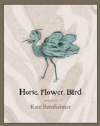Horse, Flower, Bird
In Horse, Flower, Bird, Kate Bernheimer, editor of Fairy Tale Review, gives readers eight of her own dark fairy tales centered on sad heroines. There is a certain timelessness to the tales, except for references to things like easy-bake ovens, plasticine dolls, and Star Wars, which place these stories firmly in contemporary times, or at the very least post-WWII, due to the haunting references to people in ovens. In the opening story, “A Cuckoo’s Tale,” the protagonist is a young Jewish girl who likes to atone. She describes spending Yom Kippur downtown with perfumed ladies: “Neither she nor the perfumed ladies were much interested in God. They were interested in forgiveness and, the girl vaguely understood, people who had been cooked inside ovens.” The girl traces her own fear of ovens back to stories her grandmother told, which include tales of a witch who cooks little girls to eat them.
There is a magical element to these stories, as there is in many fairy tales. There is something immediately captivating about the protagonists’ innocence, how they look at and understand the world. The stories are written in a simplistic, direct style, and paragraphs are given their own pages. In this way, the book uses white space much like poetry does. The weight of Bernheimer’s direct, seemingly simple sentences is emphasized by the blankness of the surrounding page, and some stories seem to slowly trail off as the final pages only have a single phrase or word, like “A Tulip’s Tale,” whose last three pages end, “Come back. // Come back. // Come back to me,” with each sentence existing on its own page.
There are times when this isolation of sentences on the page reminded me of children’s books, though these tales are definitely geared toward an older audience. The final sentence of “A Doll’s Tale,” a story of numerous Astrids, is: “And as perhaps you have gleaned from this story, our Astrid did not much thrive.” This sort of moralizing or plain statement of purpose/intent, is reminiscent of children’s books, but more specifically recalled for me Edward Gorey’s tragically doomed children (“A is for Amy who fell down the stairs”).
However, Bernheimer’s dark fairy tales are not all doom and gloom. In fact, I found myself laughing out loud in a number of places. In “A Cageling Tale,” the narrator describes a family who has a history of hating birds:
And the girl’s grandmother had a vengeance for birds. (She had very bad vision and once, mistakenly, got a chair upholstered in a fabric that depicted garish birds. Strangely, the girl’s mother, whose mother this was, seemed to take some kind of wicked glee in the error, and never revealed it to her.)
Later, in the same story, the girl, Edith, trains her pet parakeet to speak the phrases “You’re sexy,” “hot lady,” and “nice rack,” to upset her mother “who had phobias about words like sexy, lady, and rack.” Bernheimer deadpans, “The bird was a loyal friend.” However, this story also takes a dark turn, as Pretty Eyes, the parakeet, dies by flying into a window, and Edith runs away from home and becomes a topless dancer who is later supported by various men she met at the club where she worked inside a giant birdcage.
In “A Doll’s Tale,” Astrid’s father describes Astrid as a “delicate, odd little girl,” and this description can probably be applied to most of the girls in these stories. The girls who are at the center of each of these stories are a little odd and seem doomed from the offset. They seem isolated, are unable to like other people, or prefer the company of imaginary friends, or play games that involve passing tape recorders between “locked” walls, or live secret lives, as the narrator of “A Petting Zoo Tale” claims, “All good animals have secret lives.” They also seem to escape these lives, but to what? The first-person narrator in the final tale, “Whitework,” escapes into books. Her doctor warns: “You have the key to the Library […] Only be careful what you read.”
This is a delightful collection of strange tales. Dark, yes. But any darker than the original Grimm’s fairy tales? No. The stories are also accompanied by anthropomorphic illustrations by Rikki Ducornet, which are wonderfully befitting of the tales. This made for a quick read, as once I was pulled into the worlds of these stories, I did not want to stop reading until I found out where Bernheimer was taking me.





